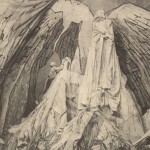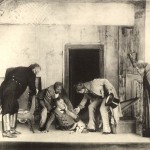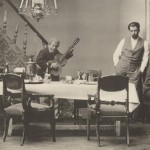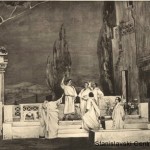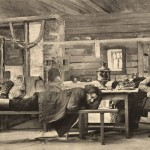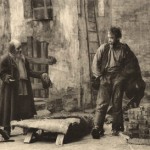Mounting Stanislavski On Stage by Paul Fryer
The 2008 Exhibition
Why are the photographs important?
The Moscow Art Theatre, under Stanislavski and Nemirovich-Danchenko was the first permanent theatre company in the world to document their work photographically. This process was established to develop a working record of productions that might move in and out of the repertoire, and provided an easily accessible resource for those engaged in re-staging productions.
For us, this photographic record provides a unique resource
In our book, Stanislavski on Stage, published to accompany the inaugural exhibition at the National Theatre in 2008, three of our contributors, Jean Benedetti, Laurence Senelick and Kathy Dacre acknowledge the value of these photographs. Benedetti makes the important point that the photographs provide indelible evidence not only of the physical staging of the productions, but also of the quality of the acting (even though the early photographs had to be posed).
Which photographs were chosen and why?
The photographs chosen for inclusion in the exhibition were self-recommending: each of the seven productions represented having been either directed or produced by Stanislavski, or being a production is which he acted. We selected from some 200 plus images in the archive, concentrating on photographs that we felt represented the spirit of the production and that would stimulate the viewer. We also intended that the scenic elements of the staging would be visible as well as the actors, in order to provide a more comprehensive representation of each production. Where appropriate, we also selected a number of “in character” shots, focusing upon individual actors posed in character, but not necessarily in the actual scene. These provide a more detailed study of the individual performer.
The essays.
Having provided a written commentary that would become part of the exhibition, in the form of captions and explanatory notes, the decision was taken to create a publication which would include some of the photographs, accompanied by a short essay, written by each of the members of our advisory board. This was intended to function as an accompanying text, offering both context and background as well as a personal perspective from each writer, rather than a simple catalogue. Each writer was asked simply to respond to the photographs in their own way; some interpreted this request by writing directly about the photographs, whilst others explored wider themes based around their own experiences of Stanislavski and his work and legacy.
The venue.
A number of potential venues was explored for housing the exhibition. It was decided to approach the National Theatre for several reasons: we wanted a high profile venue which would be easily accessible to a wide range of visitors, with the additional advantage that the building is open all day, and not only for performances – this would maximise the potential audience; It was felt that a theatre was the ideal venue in which to display material that is intensely and intrinsically theatrical – in a sense, the Moscow Art Theatre has become a kind of National Theatre in Russia, and it therefore seemed doubly appropriate that the exhibition should be within our own National Theatre.
The visitors.
The exhibition was set within a public area (the foyer of the Olivier Theatre) and it was therefore impossible for us to monitor the visitors who viewed the material. However, there was a significant and high-level interest in the opening event, which was attended by many distinguished members of the theatrical profession including Vanessa Redgrave, Ralph Fiennes, and Joely and Natasha Richardson – and attracted wide media coverage from both the UK and Russia. The official opening of the exhibition was carried out by Professor Anatoly Smeliansky, the Dean of the Moscow Art Theatre School and Associate Director of the Moscow Art Theatre.
During the run of the exhibition, the material was viewed by those attending performances in the National’s three auditoria, as well as many who had come specifically to see the photographs. This allowed for both casual detailed viewing, and perhaps attracted a wider audiences that might have attended if the exhibition had been mounted in a gallery space.
The funding.
The exhibition and the exhibition book was made possible by a generous donation made to the Centre by Evgeny Lebedev (now Editor of the London Evening Standard). Mr Lebedev was attracted to the project because of his interest in Russian theatre and culture, and his previous experience as a student, of having worked with the Moscow Art Theatre and Professor Smeliansky. The Lebedev family had been instrumental in the restoration of the Chekhov Theatre in Yalta, and had also assisted in the restoration of the Moscow Art Theatre.
The 2013 Exhibition
In January 2013, the Stanislavski on Stage exhibition was re-mounted in a revised version at Pushkin House, a Russian Cultural Centre in Central London.
The time and the place
The exhibition was re-mounted to mark the 150th anniversary of Stanislavski’s birth in 1863.
A major festival event was organised in Moscow by the Moscow Art Theatre under the direction of Professor Smeliansky. It therefore seemed appropriate that the Stanislavski Centre should become part of this celebration with our Russian colleagues. Pushkin House was an ideal venue in which to re-mount the exhibition, as it is located very centrally (in literary Bloomsbury) with easy access by public transport.
Pushkin House is an independent centre which supports the cross-cultivation of British and Russian culture by staging events ranging from literary lectures to recitals of both poetry and music, along with other live performances and a range of exhibitions. The venue also offered us the potential to present a number of contextual events to support the exhibition, as the photographs were displayed both in the main gallery area and a well-equipped lecture room.
The photographs
The choice of material included in the exhibition was governed by the same considerations as the 2008 staging, with one major difference. The venue was smaller and required a very different style of display. For example, the Olivier foyer allowed for a great deal of text to be included, whereas the Pushkin House display areas were far more limited in space. It was necessary to reduce the number of photographs to eight from each of the seven productions (making 56 in all) and restrict the text and captioning to a single exhibition board for each section (production). The incidental advantage in this was that we were able to hang the exhibition allowing more space between each exhibit. Whereas, for the 2008 exhibition, we had been able to use some very eye-catching banners, which featured blow-ups of some of the photographs, we could only include two of the smaller banners at Pushkin House. Because of the celebratory nature of this staging, we also decided to use as many photographs as possible which featured Stanislavski himself, whilst still offering a satisfactory representation of the entire production.
Panels and Lectures
One major difference in the re-staged exhibition was the opportunity to include a short series of contextual events in the form of panels or lectures.
Because of the huge significance of the late Jean Benedetti on the formation of the Centre and the genesis of the photographic collection itself, it seemed appropriate to open the exhibition with a panel discussion event which concentrated on Benedetti’s life and work, with particular emphasis on his pioneering work as a Stanislavski scholar, making the work accessible and comprehensible to a wide ranging readership via a number of ground-breaking publications – including, of course, the new Stanislavski edition, published by Routledge.
This panel was chaired by the Principal of Rose Bruford College, Professor Michael Earley, who had worked with Benedetti during the writing of some of his earlier Stanislavski material published by Methuen. The panel provided a very useful cross-section of guests all of whom had a valuable perspective both on Benedetti’s work and on Stanislavski’s abiding influence on western theatre: Professor Anthony Hozier, former Vice-Principal of Rose Bruford, had worked with Benedetti during his term as Principal of the College; Professor Bella Merlin, University of California Davis, is a contemporary Stanislavski expert, who has produced a number of key publications on this area; Katya Kamotskaia, teaches at the Royal Conservatoire of Scotland, and worked with Benedetti of the new Routledge edition of Stanislavski’s published works; Mark Stephenson, an actor director and teacher, had also worked with Benedetti, and uses Stanislavski in his work; John Gillet, also a teacher and director, is author of key texts on Stanislavski’s work.
The capacity audience at this event played a major part in the success of the evening, ranging from A Level students to many who had worked with Benedetti as performers and/or scholars.
Three further lectures were staged during the run of the exhibition:
Professor Sergei Tcherkasski from The St Petersburg State Academy of Theatre Arts, a member of the Centre’s Advisory Board, and a co-editor of the ejournal, Stanislavski Studies, presented a lecture on Stanislavski and the Contemporary Russian Theatre; Professor Jonathan Pitches, University of Leeds spoke about his book, The Russians in Britain, which traces the ways in which Stanislavski’s system has influenced the British theatre in terms of both training and approaches to performance; Professor David Bate spoke on the importance of photography in the documentation of theatre practice, making direct references to the pictures that we had included in the exhibition.
The importance of the short lecture series was that it linked Stanislavski’s work not only with history of theatre training and performance, but with current practices, emphasising the “liveness” of his legacy, not only in Russia, but all over the world.
